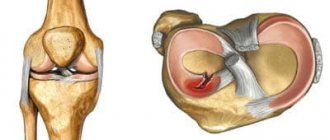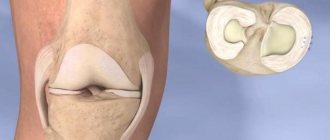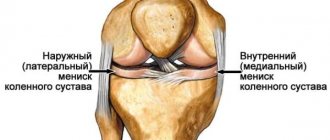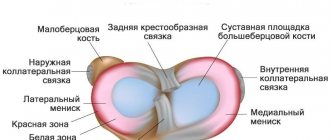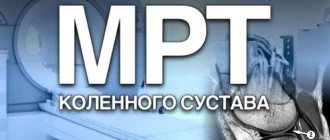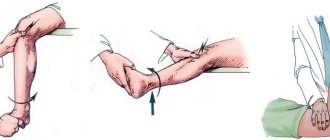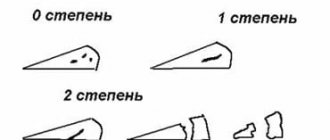The meniscus is a cartilage formation located in the knee joint. Its main functions are shock absorption and additional strengthening of the joint. In total, there are two menisci in each knee joint, the lateral and the internal. Damage to these cartilages can lead to serious impairment of the motor function of the joint.
The situation is complicated by the fact that the blood supply to the menisci is very poor. The arteries penetrating the cartilage extend only a few millimeters in it. As a result, meniscus injuries are quite common. They can be the result of injury or occur as a result of arthrosis, a specific inflammation in the joint, for example, caused by syphilis or tuberculosis, as well as a purulent inflammatory process.
Nature and symptoms of meniscus damage
Content:
- Nature and symptoms of meniscus damage
- In what cases is meniscectomy performed?
- Types of meniscectomy
- Benefits of arthroscopic meniscectomy
- Contraindications to the procedure
- Methods of pain relief
- Preparation and performance of the operation
- Postoperative period and complications
The meniscus is characterized by several types of damage: longitudinal or transverse tear; separation; compression and loss of stability. The external meniscus, due to its greater mobility, more often suffers from compression. The inner cartilage plate is prone to tearing.
The meniscus can fail if it is subjected to regular and prolonged stress. The cartilage becomes deformed and is eventually replaced by scar tissue, which, of course, can no longer perform the functions that the meniscus performs in a normal situation. Due to continued loads, the integrity of the cartilage that has undergone pathological changes is damaged.
Evidence that damage to the meniscus has occurred is the loss of the ability to move quickly and actively. When moving, distinct “clicks” are heard in the knee joint and pain is felt. Particularly difficult when the meniscus is damaged is overcoming steps - both ascent and descent. In addition, the affected joint may swell and the skin over it may become red and hot.
In the event that partial or complete destruction of the meniscus has occurred, a procedure for removing this cartilage - meniscectomy - may be prescribed.
Arthroscopic meniscal resection
When the meniscus ruptures, there are indications for removal of the torn part. Most often, a minimally invasive surgical treatment technique is used for this – arthroscopy. Arthroscopic resection of the meniscus is a high-tech safe operation that is performed through minimal incisions, under the control of an arthroscope (a fiber optic probe with a diameter of 0.5 cm, to which a light source and a video camera are attached). The operation consists of cutting and removing the damaged part of the meniscus.
After arthroscopic resection of the meniscus, you can stand on the operated leg within a few hours. The patient can be discharged the very next day after the operation. After 10-12 days, you can do the first simple loads on the knee joint. After arthroscopic resection of the meniscus, the function of the knee joint is completely restored and you can engage in sports or any other physical activity.
In what cases is meniscectomy performed?
The choice of method for repairing a damaged meniscus depends on how serious the damage is and in which area the damaged area is located.
For example, surgical intervention can be dispensed with if the tears are minor and are located in the so-called “red zone” - in other words, in that part of the cartilage where a few vessels are located. The operation is performed only if the damage is very significant and healing does not occur for a long time.
If the injured area is located in the “white zone”, where there are practically no blood vessels, then there is no point in suturing the meniscus, and you should not count on its healing “naturally”. In this case, doctors recommend meniscectomy.
In addition, it is necessary to remove the meniscus if there is a separation of the cartilage from the body of the joint, as well as if a piece of the meniscus is completely torn off. If surgical intervention is not performed, a so-called “joint block” develops. The patient experiences acute pain, and the knee completely loses the ability to move.
In most cases, specialists try to remove only part of the meniscus. However, if the cartilage is completely fragmented or the damage is multiple, it is necessary to resort to a complete meniscectomy.
In addition, complete removal is recommended for elderly patients, even if the damage is minor. Finally, the meniscus is completely removed before transplantation.
Rehabilitation after meniscus resection in our center
Surgeries to remove the meniscus are low-traumatic, so the rehabilitation and recovery stage takes little time, which is a huge plus in our modern world. If after the operations the patient does not have severe pain, light loads are allowed immediately after the operation. After 10-14 days, physiological loads are resolved, and after one month you can begin full-fledged sports loads on the knee.
The rehabilitation stage of treatment should be aimed at restoring all motor functions of the joint and strengthening the thigh muscles. The patient is prescribed therapeutic exercises aimed not at loading the leg, but at straining the thigh muscles. Doctors at our orthopedic center select an individual set of rehabilitation measures that very quickly return the patient to their usual lifestyle .
Video reviews about meniscus resection in our center
Gregorov P. - surgery September 18, 2013 Dmitry, meniscus tear - surgery September 12, 2014 Irina Gribina, 74 years old - meniscus tear Roman Ostashchenko, meniscus sports injury
Video about meniscus treatment
Types of meniscectomy
Removal of the meniscus can be done in two ways: open and closed.
An open meniscectomy involves opening the joint during surgery. It is more traumatic, and patients take longer to recover from it. In addition, the likelihood of complications is an order of magnitude higher.
As a rule, now they try not to do open surgery. It is used only to remove significant parts of the meniscus.
Surgical intervention involves making oblique incisions. The surgeon gradually dissects the skin, subcutaneous tissue, as well as the patellar ligaments, after which he opens the joint layer by layer, using special tweezers to lift and open the synovial membrane. The incision is stretched and fixed with special hooks to provide a good view of the meniscus.
At the initial stage, the anterior horn of the cartilage is cut off using a scalpel, after which the cut is carried out in the area of the posterior attachment of the meniscus. In the event that the meniscus is partially removed, after excision of the fragments, the edges are aligned, and then all the tissues of the joint are sutured layer by layer.
As noted above, this procedure is considered difficult, extremely painful for the patient and requires a long period of rehabilitation. Therefore, the arthroscopic method of meniscectomy is much more widely used today. This procedure is carried out using a special device - an arthroscope.
Resection of the medial meniscus
The meniscus itself has the following structure:
- Body of the meniscus;
- Anterior horn of the meniscus;
- Posterior horn of the meniscus.
The medial meniscus forms a much larger semicircle than the lateral one. The narrow anterior horn lies on the medial part of the tibial plateau, in front of the anterior cruciate ligament. The medial meniscus is firmly attached to the joint capsule and is therefore less mobile. This causes a higher frequency of its injuries, especially in comparison with the lateral meniscus.
Resection of the medial meniscus is performed closed, through two incisions . In this case, the arthroscope and all the necessary medical instruments are also introduced. First, the damage is inspected and the location and extent of the rupture is determined. After this, a decision will be made on the need to remove or stitch the meniscus. During resection of the medial meniscus, only the damaged part is removed, all edges of the defect are aligned.
Resection of the medial meniscus is a minimally invasive operation , so the inpatient stage of treatment lasts several days. It is important to know that a timely visit to our traumatology and orthopedics center at Clinical Hospital No. 85 of the Federal Medical and Biological Agency of Russia guarantees excellent treatment results and completely restores the physical activity of the knee joint.
Benefits of arthroscopic meniscectomy
Closed or arthroscopic meniscectomy has a number of undeniable advantages:
- This method is low-traumatic.
- The patient does not need to stay in hospital for a long time.
- With a closed operation, the risk of complications is significantly reduced.
- The patient requires much less time for rehabilitation.
- After the operation, there is no unaesthetic scar left, which is important in cosmetic terms.
- The price is more affordable than the cost of open surgery.
Due to all these factors, this method is used more often, especially if it is necessary to carry out partial rather than complete removal of the meniscus.
Contraindications to the procedure
Like any other surgical intervention, arthroscopic meniscectomy has a list of contraindications. In some cases, this operation should be postponed, and in some situations it is not allowed at all.
Thus, meniscectomy is excluded if the patient’s health does not allow the use of anesthesia and anesthesia, as well as in the case of individual intolerance to medications that will be used before, immediately during or after the intervention.
Contraindications include a number of acute and chronic diseases. Thus, intervention is excluded for heart failure and coronary disease, if the patient suffers from arrhythmia or high blood pressure. Meniscectomy is not recommended for patients with varicose veins and thrombosis.
A relative obstacle to intervention are problems of the respiratory system: bronchial asthma, chronic bronchitis. You should not operate on patients with pulmonary emphysema, as well as with diagnosed respiratory failure.
Surgery is not recommended for patients with chronic renal failure or chronic pyelonephritis. Caution should be exercised in patients with liver cirrhosis and liver failure.
Contraindications for arthroscopic meniscectomy include anemia, leukemia, and decreased blood clotting. The operation is not performed on patients with severe obesity, diabetes mellitus and a history of cancer.
There are also a number of joint diseases for which arthroscopic meniscectomy is not performed, in particular, with fibrous and bone ankylosis, adhesions and joint contracture.
Methods of pain relief
The method of pain relief that will be used during the operation is selected by the anesthesiologist purely individually, based on the results of the examination that is carried out before the intervention.
It should be noted that arthroscopic meniscectomy can use one of four methods of pain relief.
Local anesthesia
The undeniable advantage of this method is the fact that such anesthesia is quite simple and relatively safe. Moreover, when using it, the presence of an anesthesiologist during the operation is not required. At the same time, local anesthesia has its disadvantages. First of all, it is not suitable for surgical interventions that require a long time. In addition, when performing intra-articular manipulations, the process is more difficult due to the presence of a large amount of anesthetic in the joint. Finally, the patient may experience some discomfort due to the tourniquet being applied to the thigh. In connection with all of the above, doctors use local anesthesia during arthroscopic meniscus removal only in some cases.
Conduction anesthesia
Sometimes a blockade with lidocaine solution is used. The substance effectively blocks the sciatic, femoral and external nerves. The effect of such anesthesia lasts about one and a half hours.
Epidural anesthesia
An effective method is epidural anesthesia, which involves the injection of drugs into the spinal canals. At the same time, the doctor maintains visual and verbal contact with the patient.
General anesthesia
The main advantage of this method is that it makes it possible to completely eliminate unpleasant sensations for the patient and regulate the duration of manipulations. However, an anesthesiologist must be present during surgery. In addition, general anesthesia carries certain risks for the patient.
Preparation and performance of the operation
Before the operation, the patient must undergo all necessary examinations, including a consultation with a therapist and an anesthesiologist who chooses the type of pain relief. Approximately a week before surgery, you should definitely stop taking blood thinning medications.
The operation is performed in a lying position. The patient is placed on his back on the operating table, his leg is placed on a special stand. A tourniquet is placed around the thigh to temporarily restrict blood flow.
Arthroscopic meniscectomy is performed using an arthroscope. This is a special device with three tubes, each of which has its own purpose. First, the doctor makes a microscopic incision, no more than half a centimeter in length, and inserts a tube with a mini-camera equipped with a light into the joint. This device allows you to fully visualize the progress of the surgical intervention, transmitting an enlarged image to the monitor.
After this, the doctor makes two more incisions and inserts the remaining two tubes. The second tube is used to supply saline solution. It is used to rinse the joint cavity, and in addition helps to improve visibility so that the surgeon can control his every movement.
The third tube is used to introduce specific instruments into the joint, with the help of which fragments of the meniscus are removed. After all manipulations are completed, the doctor removes the equipment from the joint, treats the puncture sites with an antiseptic and applies a sterile bandage. The tourniquet is removed from the patient's thigh.
As a rule, the duration of arthroscopic meniscectomy does not exceed one hour.
If the meniscus has been removed by more than fifty percent, it can be replaced with an artificial or biological (from a donor) implant, which is implanted in place of the missing part.
What are menisci?
Menisci are cartilages in the joint cavity that serve to cushion and protect the joint itself. The meniscus can be injured both during sports exercises and in everyday life due to a fall or a sharp jerk. This pathology is often accompanied by ligament rupture, fracture, and bone displacement.
Damage to the meniscus manifests itself:
- Pain
- Restricted movement
- Damage to cartilage, which can lead to arthrosis
Until recently, it was believed that a person could live without a meniscus. When ruptured, it was usually completely removed. But studies in recent years have shown that in the absence of a meniscus, arthrosis develops after many years. Without protection, articular cartilage wears out faster. For this reason, specialists try to preserve most of the protective cartilage during arthroscopy.

